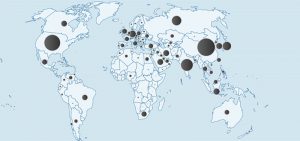CO2 levels increasing at a faster rate than before
The annual growth of atmospheric carbon dioxide (CO2) during 2015, above three parts per million (ppm) per year, was the largest ever recorded at the Mauna Loa Observatory in Hawaii, said climate researchers Wednesday.
Independent observations by NOAA’s Earth System Research Laboratory and by Scripps Institution of Oceanography at UC San Diego show that not only did 2015 have the largest increase, but also that the annual increase was larger than two ppm for each of the last four years, another first. The Scripps CO2 Group, which manages the Keeling Curve record of atmospheric carbon dioxide levels, reported this week that the average concentration of CO2 at Mauna Loa was 404.16 ppm for February. In February 2015, the monthly average was 400.30.
The large increase is partially due to the current El Niño weather pattern that leads to different patterns of temperature and precipitation over very large areas, affecting plant growth and respiration of ecosystems. The previous high point of annual CO2 growth occurred in 1998, also a strong El Niño year.
“We rose above 400 ppm last fall at Mauna Loa and have remained above it since,” said Ralph Keeling, director of the Scripps CO2 Group. “It looks like we’ll stay above 400 ppm indefinitely.”
Last year the underlying multi-year average growth rate was higher than ever because the rate of emissions from the burning of coal, oil, and natural gas has experienced a steady upward trend. Lowering the emissions will slow down the CO2 growth rate, but not stop it. The excess concentration of CO2 in the atmosphere and oceans (where it causes acidification) can be expected to peak when emissions have been brought down to zero.
“Carbon dioxide levels are increasing faster than they have in hundreds of thousands of years,” said Pieter Tans, leader of NOAA’s Global Greenhouse Gas Reference Network. “It’s explosive compared to natural processes.”
In December 2015 in Paris, all nations pledged to cut their emissions, while recognizing the urgency of achieving deep reductions in emissions. The current record rate of CO2 increase confirms that their judgement is correct, said researchers. The last time Earth experienced a sustained CO2 increase was between 17,000 and 11,000 years ago when the Earth emerged from the last ice age. Today’s human-made CO2 increase is 200 times faster, a dramatic rate compared to natural processes, Tans said.
– Robert Monroe

